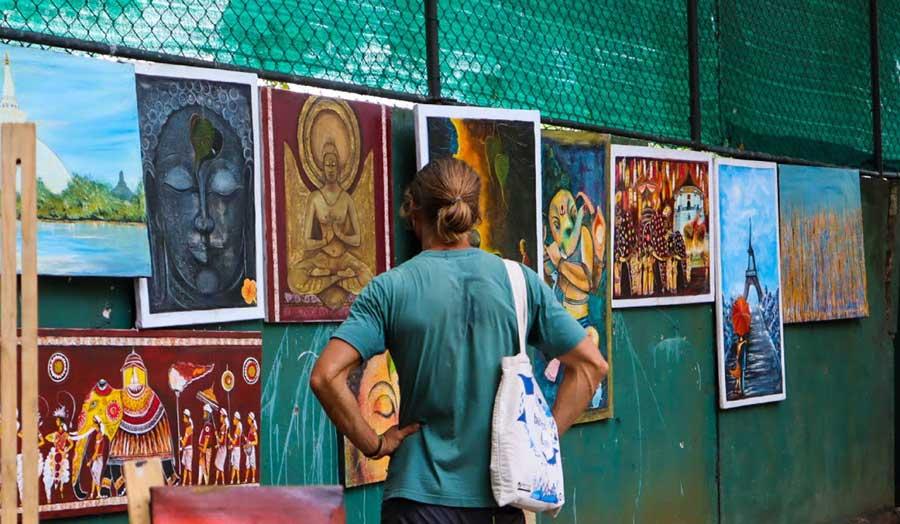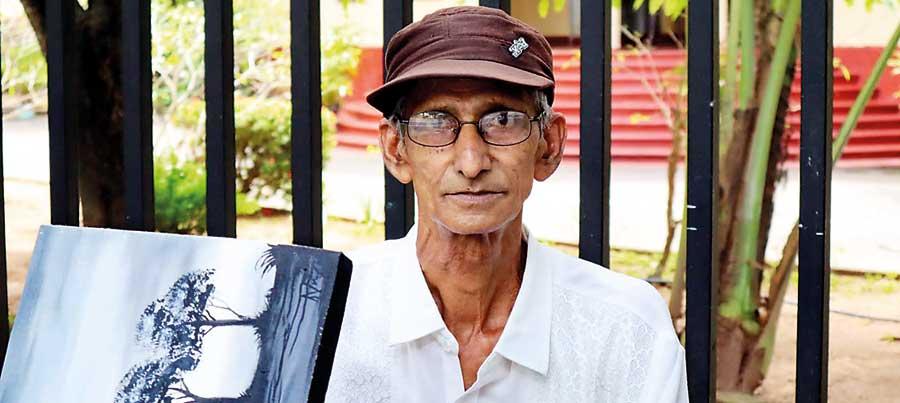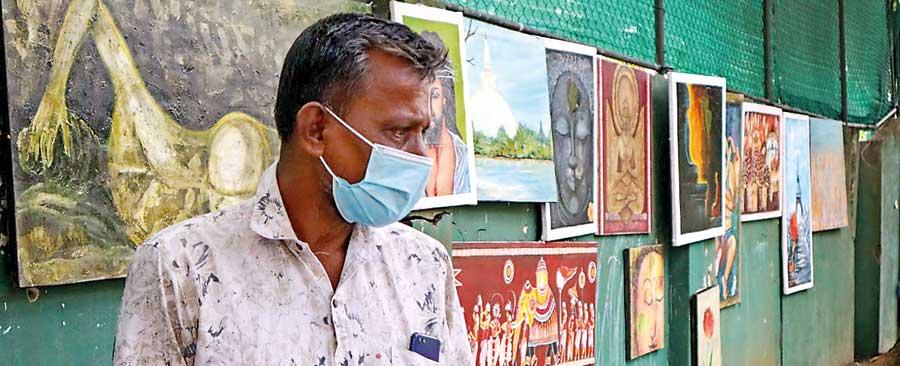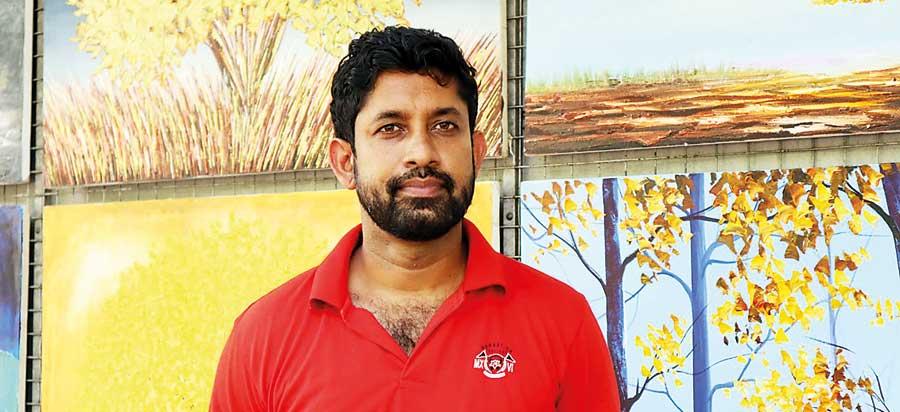12 Jan 2022 - {{hitsCtrl.values.hits}}

A tourist looks at the artwork for sale oppsite Viharamahadevi Park, Colombo
The art industry in Sri Lanka always had its fair share of challenges and the pandemic hasn’t made it any easier for many of the artists who rely on it and pour all their time and energy into their work. The field of art, being one of the earliest forms of expression and depiction of emotions, senses and intellect is swept under the rug whenever a crisis unfolds. And in Sri Lanka, this situation is no different, especially when you meet the artists who sit with their artwork by the streets, with hopes to sell at least one piece of work a day.
easier for many of the artists who rely on it and pour all their time and energy into their work. The field of art, being one of the earliest forms of expression and depiction of emotions, senses and intellect is swept under the rug whenever a crisis unfolds. And in Sri Lanka, this situation is no different, especially when you meet the artists who sit with their artwork by the streets, with hopes to sell at least one piece of work a day.
Lack of tourists
We spoke to several artists opposite the Viharamahadevi Park who have their paintings hung up for days on end, and asked about their current situation, livelihood and how they coped with the two years of the pandemic. One common problem seems to be the obvious decrease of tourists and its impact on them.
Artist Malinda Perera, told us that their income has decreased significantly since the start of the pandemic with fewer buyers than before. Even though there used to be an equal percentage between both local and foreign buyers, a big decrease in the sale was recorded due to the pandemic.
" Most of the younger generation doesn’t consider art as a stable industry that could provide enough to feed their families. The older artists who cling on to their love for their career feel rather hopeless and helpless when they are faced with numerous challenges that we see today"
Malinda’s family members are all artists; himself, his brother and his father. It’s the only skill that they’re familiar with and their only source of income. It was obvious that they are trying to make ends meet through the business of commercial art and were feeling rather lost in terms of their future plans. “We don’t have any plans, and we’re left with no option,” he said.
Kulasooriya, another artist said that some of them have started to sell their art online and have started taking online orders. But Kulasooriya alone hasn’t got the finances to initiate it - a proper platform to sell art online.
“There are days on which they won’t sell a single canvas,” another artist named Sripalee Rathnayake said. When locals do decide to buy, they always seem to bargain and demand unfair discounts on pieces of work that took weeks to complete, he added. “But sometimes out of desperation, we would agree, because we find ourselves helpless and left with no other choice,” Rathnayake said.

Kulasooriya
The economic crisis and fears of a lockdown
Rathnayake explained that they are afraid of lockdowns. With every Covid wave, they get into a dire situation of not having any buyers for their art. “People are struggling to find money to even feed themselves, so why would they spend thousands on a painting?” he said gesturing towards his canvases hopelessly. He also said that some local buyers bargain ruthlessly only because they sell their work on the ‘pavement’. Rathnayake said however, that he was able to make a little more money by doing wall paintings for hotels and restaurants.
“When we see a customer walking from a distance, we start painting new ones here. That’s how desperate we are sometimes. We can’t afford to waste our time, we have families to feed and art is our only choice.”
The goal of these struggling artists is to secure at least a few thousand rupees a day, but people aren’t that willing to buy them as they used to, they said. “When we see a customer walking from a distance, we start painting new ones here. That’s how desperate we are sometimes. We can’t afford to waste our time, we have families to feed and art is our only choice.” Rathnayake said, while explaining to us how long it took to complete each painting.
Kulasooriya, who was working on a beautiful black linear painting while talking with us, told us that he has started an online business selling art, but COVID has definitely impacted their sales. “Online selling has helped us a little but it will take a long time for us to get back to the sales we had prior to the pandemic. Until then we have to make do with what we have.” He explained that the minimum price for one of his artworks is Rs. 2500 and that painting is the only skill he solely depends on. “The past two years have brought down our sales drastically. This is something that we had never come across over the last 20 years”, said Perera. He noted that it’s been hard to afford canvas and new painting supplies since the pandemic struck, as the price of those products too have increased.

Sripalee Rathnayake
Unrecognized skills
We observed that most of the older artists here never had any higher educational qualification in art to validate their ability in the field. Rathnayake explained that whatever skill they possess is from honing their natural talent. He added that their capabilities aren’t recognized as much as university art graduates. Therefore, they are rather limited in what they can do in terms of their future other than produce art and sell them. “I do art because it’s my passion. I’m devoted and attached to it. I don’t have certificates to validate it, but my work speaks for my talents” he said.
"These artists do not even have a place to display and sell their work"
Kulasooriya’s daughter and son-in-law have both studied at an art academy and Rathnayake’s daughter is a gallerist. Through our conversations, it was evident that the next generation of the art industry is seeking higher standards and a better status in this field as opposed to their elders. Perera too said that he and his father and brother are self trained artists, adding that they will be relying on this in future too. Also another salient feature that these three artists mentioned is that it mostly takes around three to four days for them to complete a portrait, and at times a week or two if the piece is a large one. Yet, their time and energy sometimes goes in vain, if they are unable to protect their precious work from extreme weather conditions, preserving them for months and waiting until someone purchases the art.
“People are struggling to find money to even feed themselves, so why would they spend thousands on a painting?”
The artists believe that the field of art is not recognized as a profession in comparison to the other fields, because their work in this field is seen as menial or unimportant. They said that it’s very rare to find people who are willing to enter the art industry or improve it. Most of the younger generation doesn’t consider art as a stable industry that could provide enough to feed their families. The older artists who cling on to their love for their career feel rather hopeless and helpless when they are faced with numerous challenges that we see today, they said. According to them, this industry and their talent was celebrated in the past, unlike today.

Malinda Perera
Little aid and opportunities in the art industry
Another crucial factor that has affected this community is the lack of opportunities to learn new knowledge or skill, along with minimum opportunities of getting exposure for their work. These artists do not even have a place to display and sell their work. We rarely see educational establishments dedicated to art and craft and fewer workshops for people who want to enhance their skills in the art industry. Those who couldn’t gain a university education in art are left to their own devices and aren’t given alternative educational opportunities to develop and continue their work.
Art has constantly been an underrated field in Sri Lanka and with the COVID- 19 pandemic; a once vibrant community has descended into helplessness. Although the pandemic caused a massive change in the lives of these artists, their talent remains a national treasure. Their only wish is to be recognized and get the support they deserve.
26 Nov 2024 4 minute ago
26 Nov 2024 21 minute ago
26 Nov 2024 26 minute ago
26 Nov 2024 44 minute ago
26 Nov 2024 51 minute ago